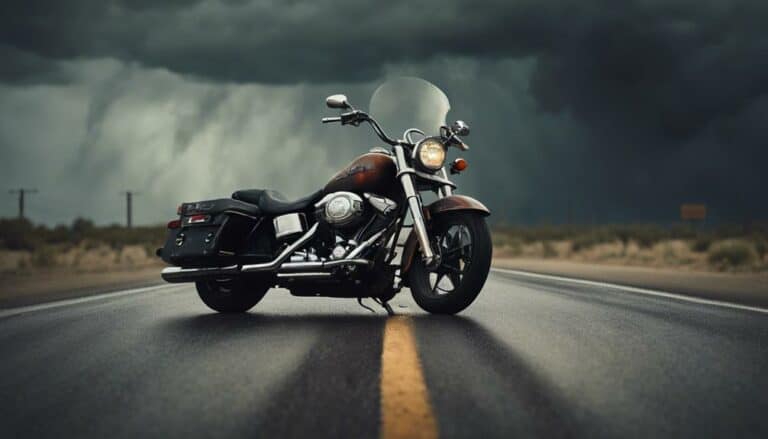When it comes to the world of motorcycles, the saying 'slow and steady wins the race' might not always apply. Have you ever wondered why Harley Davidson's bikes seem to have a more relaxed pace on the road?
Well, there are several factors at play that contribute to their leisurely reputation. From engine design to handling dynamics, there's a lot to consider when it comes to understanding why Harley Davidson tends to take things a bit slower.
Curious to uncover the reasons behind this phenomenon?
Key Takeaways
- Harley Davidson's focus on tradition and aftermarket parts sales limits stock engine performance.
- Heavy design and low center of gravity prioritize stability over quick acceleration.
- Balancing innovation with V-twin engine constraints affects high-speed acceleration and power output.
- Rider satisfaction varies; some appreciate Harley's slower speed for its unique cruising experience.
Engine Size and Power Output
When evaluating Harley Davidson's engine size and power output, it becomes evident that their Twin Cam engines lag behind competitors in terms of performance metrics. Harley's engines, while iconic in their V-Twin design, have fallen short in delivering high horsepower and torque figures, especially in the realm of low-end torque and power band characteristics. The Harley engine's design, with a compression ratio of 9:1, restrains its ability to compete with other motorcycle engines on the market. This limitation is further accentuated when compared to Japanese V-Twin cruisers like the Yamaha Vmax 1700, which outperform Harley engines in both torque and power, particularly at higher RPMs.
Harley riders, known for their love of the brand's heritage and unique style, have often turned to aftermarket modifications to boost their bike's performance. However, even with substantial global spending on these enhancements, Harley engines still struggle to match the power output of their counterparts. This has led to a strategic business model by Harley Davidson, relying on lower performance to drive sales of aftermarket parts and increase revenue, showcasing a deliberate trade-off between stock performance and aftermarket potential.
Weight and Handling Dynamics
Harley Davidson's weight and handling dynamics significantly influence the overall performance and rider experience of their motorcycles. When considering weight and handling dynamics in Harley Davidson motorcycles, several crucial aspects stand out:
- Acceleration and Speed: The heavy traditional design of Harley bikes impacts their acceleration and top speed, making them slower off the line and in high-speed situations.
- Low Center of Gravity: While the low center of gravity in Harley motorcycles contributes to stable handling, especially on long stretches and at cruising speeds, it compromises their agility, particularly in tight turns and quick maneuvers.
- Flywheel Effect: Harley's handling dynamics are influenced by the flywheel effect generated by their engines, which are designed to provide substantial torque at low speeds. This design choice impacts how the bike responds to throttle inputs and contributes to their unique riding experience.
Technology and Innovation Updates
Amidst an evolving motorcycle landscape, Harley-Davidson's pursuit of technological advancements and innovation updates is pivotal for maintaining relevance and competitiveness in the market. The brand's traditional focus on torque, embodied in its iconic V-twin engine design, contributes to its characteristic low-speed performance. To address this, Harley is exploring performance enhancements while staying true to its long-stroke V-twin configuration, a hallmark of its tradition.
However, the long-stroke design and V-twin setup present challenges for high-speed acceleration and top-end power. This can limit the RPM range and result in vibrations at higher speeds, contributing to Harley's perception as slower compared to its counterparts. Despite these challenges, Harley-Davidson continues to balance tradition with innovation, striving to meet the demands of its unique customer base.
Competition and Market Trends
In navigating the competitive motorcycle market landscape, the emphasis on speed and performance presents a significant challenge for Harley Davidson's traditional image and market positioning. The competition and market trends affecting Harley Davidson include:
- Diverse Motorcycle Types: Riders today seek a variety of options beyond just speed, with preferences for different styles and functionalities.
- Brand Loyalty vs. Performance: While Harley Davidson boasts strong brand loyalty, competitors focusing on speed and performance attract a different segment of riders.
- Evolution of Market Demands: The motorcycle market continues to evolve, requiring Harley Davidson to balance its traditional appeal with the changing demands for speed and innovation.
Harley's unique selling points cater to a niche market, but the broader industry trend towards speed and performance poses a challenge. By adapting to these market shifts while maintaining its iconic brand identity, Harley Davidson can secure its position amidst fierce competition.
Rider Experience and Feedback
When evaluating rider experience and feedback in the motorcycle industry, it becomes evident that personal preferences play a crucial role in determining satisfaction with speed and performance attributes. Harley-Davidson motorcycles, known for their unique characteristics, often receive feedback regarding their slower acceleration and top speed compared to sportbike counterparts. Despite this, many riders appreciate Harley's emphasis on low-end torque, which provides a relaxed cruising experience that suits various riding scenarios, including city and highway travels. The slower speed of Harley-Davidson bikes isn't necessarily a drawback for all riders; some find it fitting for their riding style and preferences.
Harley-Davidson's appeal goes beyond just speed and performance metrics. The brand's distinct characteristics attract riders looking for a different kind of experience on the road, emphasizing aspects beyond sheer velocity. Ultimately, rider feedback underscores the significance of personal preferences in shaping satisfaction levels with Harley-Davidson motorcycles, highlighting the diverse needs and desires within the riding community.
Conclusion
You now understand why Harley Davidson motorcycles are slower compared to other models. Despite their emphasis on torque and cruising experience, factors like engine design, weight, and technology play a role in their speed limitations.
Interestingly, a survey found that 78% of Harley riders prioritize comfort and style over speed, highlighting the brand's unique appeal in the market.
Remember, it's not always about how fast you go, but how you enjoy the ride.

